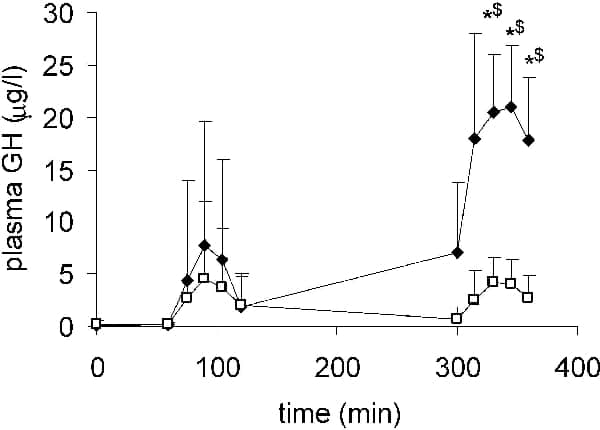Growth hormone (GH) release following the second of two sprints has previously been found to be inhibited (Stokes et al. 2005), possibly via elevated systemic free fatty acids (FFA), which can inhibit GH release at the level of the pituitary (Casanueva et al. 1987). Plasma FFA concentrations can be reduced through suppression of lipolysis using nicotinic acid (NA). The aim of this study was to determine whether plasma FFA can modulate the GH response to exercise. It is hypothesised that when plasma FFA concentrations are low, the GH response to exercise will be augmented. Following familiarisation, 7 active men (26 ± 3 yr, 1.77 ± 0.05 m, 81 ± 8 kg) performed two trials in a random order, separated by at least 7 days. For 2 days prior to each trial, participants consumed a prescribed high fat diet (isoenergetic with their normal diet; ~20% carbohydrate, ~60% fat, ~20% protein) and refrained from exercise, caffeine and alcohol. Each trial followed an overnight fast and consisted of two 30-s cycle ergometer sprints separated by 4 h of recovery. In one trial (NA), participants ingested a total of 2 g of NA over 3 doses: 1 g ingested 60 min before the sprint 1 and 0.5 g at 60 and 180 min after sprint 1. The other trial was a control (Con) trial. Finger-prick blood samples were taken before the first dose of NA and immediately before and 15, 30, 45 and 60 min after each sprint. Whole blood was centrifuged and plasma stored at -20°C for later determination of GH (DSL Inc., Texas) by routine ELISA and FFA ([NEFA] Wako, Germany) by spectrophotometry (Cobas Mira N; Roche). Repeated measures ANOVA was performed and specific differences were identified using paired t tests with Bonferroni correction for multiple comparisons. Statistical significance was accepted at P<0.05; data are presented as mean ± SD. Plasma FFA was not significantly different between trials prior to sprint 1, but was significantly lower in the NA trial immediately before sprint 2 (NA vs. Con; 0.08 ± 0.05 vs. 0.75 ± 0.34 mmol/l, P<0.05). Peak GH and integrated GH were significantly greater following sprint 2 in the NA trial compared to sprint 1 in the NA trial (peak GH, 23.3 ± 7.0 vs. 7.7 ± 11.9 μg/l, P<0.05; integrated GH, 1076 ± 350 vs. 316 ± 527 μg/l/60 min, P<0.05) and sprint 2 in the Con trial (peak GH, 23.3 ± 7.0 vs. 5.2 ± 2.3 μg/l, P<0.05; integrated GH, 1076 ± 350 vs. 206 ± 118 μg/l/60 min, P<0.05). However, peak and integrated GH were not different after sprint 1 and sprint 2 during the Con trial (Fig. 1). In the Con trial, GH release was not inhibited following sprint 2, contrary to previous findings. However, suppression of lipolysis resulted in a significantly greater GH response to sprint 2 in the NA trial. This suggests a role for plasma FFA in modulating GH release following sprint exercise.
University College London 2006 (2006) Proc Physiol Soc 3, C47
Oral Communications: Growth hormone responses to repeated sprint exercise with and without suppression of lipolysis in men
Keith Stokes1, Chris Tyler1, Kate Gilbert1
1. Sport and Exercise Science, University of Bath, Bath, United Kingdom.
View other abstracts by:
Figure 1. Plasma GH following sprint 1 (60 min) and sprint 2 (300 min) in the NA (closed diamonds) and Con (open squares) trials. * P<0.05 vs. same time point in Con $ P<0.05 vs. resting sample in NA.
Where applicable, experiments conform with Society ethical requirements.

